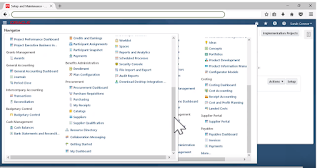After installation of ADFdi client, the add-in "Oracle ADF Desktop Integration Add-in for Excel" in MS Excel cannot be enable.
Besides, "Load Behavior" is "Unloaded".
Steps :
---------
1. Uninstall the Oracle ADFDi program from Control Panel>Add Remove program.
2. Login to FA
3. Navigator > Tools > Download Desktop Integration ..
4. Download setup.exe and execute it to install ADFdi
5. Login to FA
6. Navigator > Workforce Management > Data Exchange
7. In Tasks pane, click "Initiate Spreadsheet Load"
8. Click "Create Spreadsheet" icon of Create Worker
9. Open "HcmGenericSpreadsheet.xlsx" by Microsoft Office Excel
--> MS Excel open, but the spreadsheed does not work, that is, it does not try to connect.
[Excel]
10. Click 'Excel Options' button
11. Click 'Add-Ins' from the menu
12. Select 'COM Add-ins' value from Manage LOV at the bottom of the page, and click 'GO' button
--> 'Oracle ADF Desktop Integration Add-in for Excel' is listed, but unchecked.
Load Behavior: Unloaded
13. Check 'Oracle ADF Desktop Integration Add-in for Excel' and click 'OK' button
14. Again, do steps from 10 to 12
--> 'Oracle ADF Desktop Integration Add-in for Excel' is listed, but unchecked still.
Solutions
Steps :
---------
1. Please ensure that .NET programmability support is enabled.
1) Uninstall the current client
2) Enable .NET programmability support
2.1) Click the Windows Start button, and choose Settings > Control Panel.
2.2) In the Control Panel, select and open Add or Remove Programs.
2.3) Select the entry in the Add or Remove Programs dialog for Microsoft Office and click Change.
2.4) In the Microsoft Office dialog, choose Add or Remove Features, and click Continue.
2.5) In the Installation Options page, expand Microsoft Office Excel.
2.6) Select .NET Programmability Support, and choose Run from My Computer from the dropdown list.
2.7) Click Continue to install the .NET Programmability Support feature, and
2.8) Close the dialog when installation is complete.
3) Install the matching client.
2. Enable the addon
1) Click Microsoft Office button - Excel options - Add-Ins
2) In the Manage box, click Disabled Items, and then click Go.
3) If the AdfDI addon is listed, select it and click Enable
4) Again, navigate till Addons - In the Manage box, click COM Add-ins, and then click Go.
5) In the COM Add-Ins dialog box, select the check box next to the AdfDI add-in - OK
In the event that the add-in is installed but does not load properly , please refer people to Doc ID 2010222.1
Using the Client Health Check Tool
Use the health check tool to find out what integration issues you might have and how to resolve them. Ask your help desk if you are unable to find or use the tool.
Download the latest version of the health check tool from How to use ADF Desktop Integration Client Health Check Tool (2010222.1) on My Oracle Support at https://support.oracle.com.
Run ClientHealthCheck.exe as you would other programs on your computer, and review the result for each checked item.
Select any item that has a problem, and read the help text.
Fix some of the problems by clicking the Fix Problems button. Otherwise, follow the instructions in the help text.
If you need more assistance, click the Save Report As button to prepare information for your help desk.
Review the report and remove any sensitive information.
Contact your help desk and provide your report.






